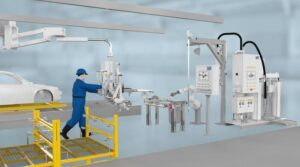Durr develops innovative concept for human-robot collaboration (HRC)
- HRC concepts to accelerate automation of final automotive assembly operations
- Example: gluing in fuel tanks during final vehicle assembly
- In case of contact: robot stands still within milliseconds
Human-robot collaboration (HRC) is a new trend in industrial production. This involves skilled workers and robots tackling a production stage jointly, each contributing their respective strengths. The company Durr has now presented one of the first HRC concepts for automotive production. When gluing in fuel tanks during final vehicle assembly it increases quality, saves time and cuts unit costs.

Contents
HRC concepts to accelerate automation of final automotive assembly operations
Automotive body shop and paint shop operations are highly automated nowadays. A modern paint shop includes a good 100 robots. Final assembly systems, on the other hand, feature a significantly lower level of automation since many processes are complex and require flexibility. The automotive industry is expecting HRC concepts to accelerate the automation of final assembly operations and thus increase production efficiency.
Example: gluing in fuel tanks during final vehicle assembly
In Dürr’s HRC concept for tank fitting a skilled worker moves the tank to the workplace and cleans it. A robot equipped with an applicator for adhesive then takes over. It applies a bead of adhesive to the edge of the tank in the predefined cycle time. Sensor monitoring ensures that the bead is absolutely uniform. The skilled worker then attaches the tank precisely in the body.
In case of contact, robot stands still within milliseconds
Dürr developed the entire robot cell for this process. This includes, for example, the material feed, the dispensing technology for a controlled adhesive flow, and the control unit. Particular importance is attached to the issue of safety. The robot is positioned such that contact with the human colleague is more or less ruled out. Should contact occur nevertheless, the robot, which is equipped with multiple sensors, comes to a standstill within milliseconds. The robot operates slowly, using rounded components and always below head and chest level.
